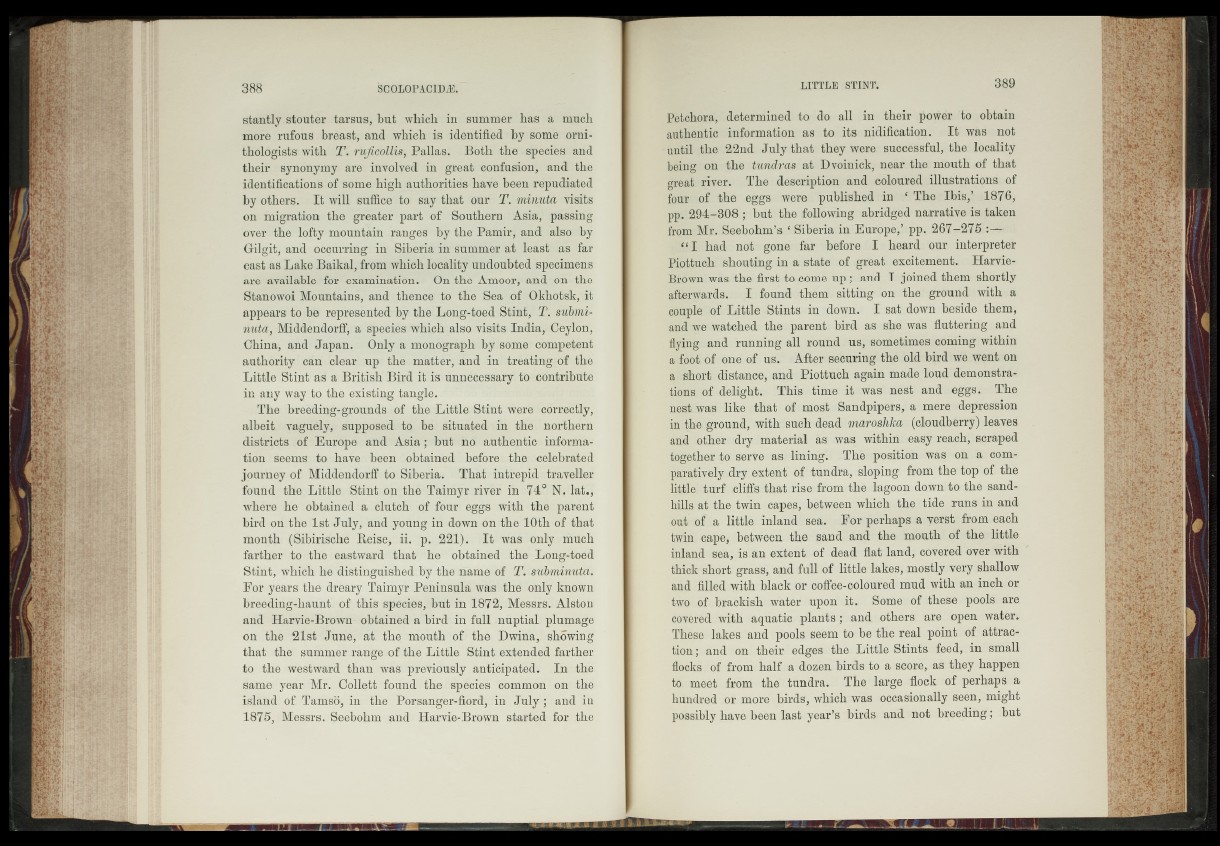
stantly.stouter tarsus, but which in summer has a much
more rufous breast, and which is identified by some ornithologists
with T. ruficollis, Pallas. Both the . species and
their synonymy are involved in great confusion, andl the
identifications of some high authorities have been repudiated
by others. It will suffice to say that our 21; minuta visits
on migration the greater part of Southern Asia, passing
over the lofty mountain ranges by the Pamir, and also: by
Gilgit, and occurring in Siberia in summer at least as far
east as Lake Baikal, from which locality undoubted specimens
are available for examination.- On the Amosor, and on. the
Stanowoi Mountains, and thence' to thé Sea - of Okhotsk, «it
appears to be represented by the» Long-:toed iStiht’,! T. submi-
nuta, Middendorff, a Speciés which-also, visits Indian jGëylan.
Ghina, and Japan. Only a monograph« by.-some competent
authority can clear up the-matter, and in treating;ofetbe
Little Stint as* a British Bird ft is unnecessary to ?cdntrihn<te
in any way to the existing tangle..''
• The breeding-grounds of the Little Stint were correctly,
albeit vaguely, supposed, tot be.: situated in the Jnorfhern
districts of Europe and- Asia; bufrrho! authentiek information
èeems to haye been .obtained l befOre.. the .»celebrated
journey of Middendorff tOiSiberia: That initrepid/*traveller
fodnd the Little Stint on the Taimyr.rivèr in'74?iMq lat.,
where he obtained .a,'blutehöof-'feur; eggs with ;the. parent
bird on the 1st July, and .young in down on ÄicfÄth of that
month (Sibirische Reise^ ii. p. 221.); It was.;;oaliyfmuch
farther to 1 the geastwardItbab ber obtained-jlh^-Longiteed
Stint, wbibn hh :Siis'fefinguMied‘;M^th©'Ämej^f; svibminutu.
For years the drëary Taimyr Peninsula was thé only known
breeding-ffiaunt. ofi this species,-but in I'872, Messrs; Alston
and Harvie-Brown—obtained a^hirM® in full, „nuptial; plumage
on thé 21st Juneft'af the:mouth ©£> the Dwina, showing
that- the summer ränge.of the Little Stint extended farther,
to the westward than iwas; previously, anitioi|)aifed';- |pliRithe
same: year Mr. GhMett found the species 'èbmm«b©mfTtbe
island of Tamsü, rinlvthe Borsanger.-fiord, in July pand in
1875, «Messrs. Seebohm and Harvie-Rfown started for tbe
Petcbora, determined -to do all in their powér to .obtain
authentic information as to dts. nidification. It was not
until the 22nd July that they were successful, the locality
being on the near the mouth of that
great-rivers ,/The .description and coloured illustrations-of
four of -the eggs were- published in ‘ The Ibis,’ ;1876,
ppi§94-308; but the following abridged narrative is taken
from Mr. Seebohm’s | Siberia in Europe,’vpp, 267-275 ;■—
mI had .not gone, far before I heard, our interpreter
Kottuch shouting in a. state of great excitement. Harvie-
Brown was the first to. come u p ; and I joined them shortly
afterwards. I found them sitting l^n the ground with a
couple of-Little Stints, in down. I sat down beside them,
and we watched' the parent bird as she was fluttering, and
flying and running all round us, sometimes coming within
a -foot of 'one. ©f' us. After securing the old bird we went on
a short distance, and rBiottuch again made loud demonstrations,
of delight., ;TMs 'time idbwas nest and eggs. The
nestrwas, like .that of. most Sandpipers,, a mere depression
in^hoground, With.-such dead maro^hka: (cloudberry) leaves
and other dry material as was within easy reach' scraped
together-to,serve as lining! The position was on a, comparatively
.dry entehtf of tundra, sloping from tbe top of the
lit&le' turf cliffs ithaf;rise: feom’ the£3fag.o©p;dojwn.to the sandhills
at the twin capos, between which' the tide runs in and
©at of a little, inland sea. vFor perhaps a verst from each
twin cape, ^between the sand and the mouth of the Kèfefe
inland sea^s an extents:of dead fiat.land, covered over-with
thick- short grass., and fiill of little:lakes, mostly very shallow
and -filled-with, black or coffee-coloured mud with an-inch or
two b r a c k i s h water upon Ipgi Some-, of these pools are
covered with aquatic* plants- and others, are open -water»
These, lakes; ,a;nd .pools:'seem. fe®<be the real point, of attraction
; and on their:, edges, -the Little Stints feed, in small
flocks of from half/-a dozen.Mrds to a score, as they happen
tn meet from the .tundra. The large flock of perhaps a
hundred on.more birds, which was occasionally seen, might
possibly have, heen last . year’s birds and not breeding; but